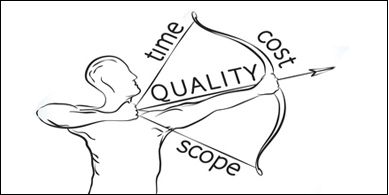Applying “A Sense of Urgency” to Project Management
In his most well-known book, Leading Change, Dr. John Kotter presents an eight step model for transforming organizations with the first step requiring the establishment of a sense of urgency. Dr. Kotter expands his guidance for completing that first step in his follow-up book, A Sense of Urgency.
While Dr. Kotter’s premise is that companies and individuals need to develop and sustain a true sense of urgency to successfully survive today’s fast pace of change, his lessons also apply to project management.
This might seem like an odd topic to write about – project managers frequently feel over-pressured to deliver and that same pressure often translates to their team members. However, even on critical, high visibility projects, it can be difficult to sustain focused, productive true urgency.
Dr. Kotter states that the enemies of true urgency are complacency and a false sense of urgency.
Don’t these also apply to projects?
When you are leading a long duration project, it can be a common behavior for the team to develop tunnel-vision, focusing all their efforts on that next critical milestone. Through a combination of good team work, but also excessive heroics, that milestone is achieved. But what happens afterwards if the next milestone is more than a few weeks off? Does the team maintain their productivity at the same pace as their lead up to the milestone or do they breathe a sigh of relief and take their foot off the gas pedal? A sense of complacency has settled in. If you were to map the output level against time, you might see the build up to a milestone and then the drop off afterwards – success has become its own worst enemy.
While complacency is bad, a false sense of urgency is lethal. It can be easy to detect when productivity is slowing down and complacency has settled in, but it can be more difficult to identify when the frenetic pace of team member activity is not helping the project. Everyone seems to be really busy but is this true urgency? And if everyone is rushing around, harnessing and aligning their efforts to the right direction can take a lot of effort.
One way to test the waters is to find out if a team member knows what their top three activities are at the beginning of the day, and then assess at the end of the day how much progress they were able to achieve against those activities . If you find that more than a few of the team members, or even worse, you are unable to focus on progressing priorities in spite of a lot of effort being expended, the team is likely suffering from a false sense of urgency.
Sometimes this could result from poor risk or stakeholder management as both of these conditions can result in a backlog of challenging issues to resolve. Other times, it might be the inability of the project manager to effectively shield the team from sources of distraction such as frequent direct requests for project updates from different stakeholders.
So how do we prevent complacency or a false sense of urgency?
Dr. Kotter provides four tactics which should be used in conjunction. Each of these is applicable in the project management context.
Bring the outside in: This might be as simple as having the sponsor attend every second or third team meeting to recognize the team for their efforts, but to also reinforce the criticality of sustained effort. Depending on the nature of the project, if it is hard for the team members to envision the benefits which the project will deliver, it might be beneficial to bring in customers or stakeholders who are eagerly awaiting the completion of the project to provide their own encouragement and motivation.
Behave with urgency every day: This one is a bit trickier as it requires self-awareness. It can be so easy to fall into the habit of allowing decisions to be prolonged or accepting estimates at face value even when we know that they could be improved. When a team member says that a particular action can’t be completed by a given date, do we ask “What can I do to help improve on that?”. How often are we asking our team members what are their top three priorities and checking whether they have achieved those?
Find opportunity in crisis: One way to apply this tactic might be to help the team identify key lessons from a crisis and to use the heightened attention and support during the crisis as leverage to remove organization or process blockers. Dr. Kotter’s suggestion to selectively generate a crisis to overcome complacency and forge stronger team bonds could also be considered so long as that doesn’t blow up in the project manager’s face!
Deal with NoNos: NoNos are those people who effectively kill true urgency by either promoting complacency or encouraging a false sense of urgency. It might be the team member who is constantly distracting the rest of the team with perceived issues or the stakeholder who presents carefully selected data to support the assertion that there’s no harm if the project’s timeline slips. While you might not be able to directly push them out of your organization, actively distracting them if they are not on your team or exposing their behavior such that the social forces within the team cause them to reduce or stop it may work well.
On a long running project, a true sense of urgency can ensure that early successes aren’t eclipsed by late inning failures. Team members and stakeholders then take what they learned from that one project being led with a true sense of urgency and apply that to their next project.
And that is how successful organization culture change happens.
Don’t forget to leave your comments below.





